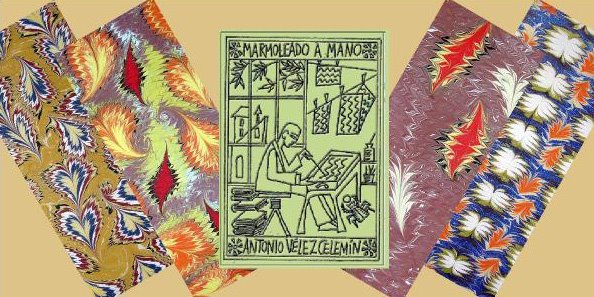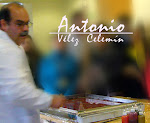ANTONIO VÉLEZ CELEMÍN
Marbled Papers Exhibition
in The Art Box of La DOMINOTERÍA (Madrid)
From March, the 24th, until April, the 13th, 2012.
The diary of an apprenticeship.
I. The beginnings.
 1
1
Nº 1 is the paper that make me understand that I could marble decently some day. I used it for the only binding that I have presented to a contest, The world tour, of Julio Verne, exhibited here in a show window.
At first it is a madness, one try everything, nº 2 wanted to be another pattern, the angelfish, but I did not have the correct measures of the comb by then and the M that turns out very clear, maybe it’s Casiopea, I could never get it again. In nº 3 I used fifteen different colors when it’s not need of even the half for a good paper. Nº 4 is regulated badly and not very well done, but they filmed me doing it, and that smile is still with me.
I soon learned to draw in the edges of the color.
It seems obligatory to try stones patterns: small, big or bigger. My great satisfaction came with the nº 9, a reproduction that was ordered to me and that I could make from a bit of a sample, which is shown in the center.
Chemicals are another attraction of the beginnings, potassium nitrate to make nº 10, the suns or tiger eye. Alun for the 101 Dálmatas that appears in the nº 11; I do not remember what I used in nº 12 and but it was linseed oil in nº 13. Then, for not burn my hands, sometimes I used soda, I have never returned to them.
Combs! Combed patters¡ These are the models that more I like to make:
A French garden is nº 14, because it is a “fleur de lys” to the green, and a model of personal invention is nº 15.
 16
16 17
17 18
18 19
19 20
20 21
21
I learned the importance of spilling every drop of color in the suitable place, and it turned out to be very easy to make changes on some of the designs of Christopher Weimann, whose books are exposed here. Perhaps the top of the regularity is the nº 20, but I should have done nº 21 in the same moment, as it has the same colors exactly, but sometimes, just after doing a great effort to obtain the biggest regularity, one relaxes and obtains similar results, although in the opposite way.
Making some changes in the Weimann style, one arrives, almost accidentally, to the Turkish model Hatip Ebrû , the regular repetition of a motive or several on a stones background. Naturally , very quickly I changed the stones background, nº 22,23,24 and 26, into a combed background, nº 25, 27 and 28. The latter model seemed very funny to me, I named it the Rolling Stones Hatip Ebrû, for its similarity with the "logo" of the famous musical group.
 29
29The double models are a permanent temptation; I have never stopped doing them. Nº 29 was one of the first ones that I kept. It is like Alpine scenery, or at least that seems to me.
A hearts dance is nº 30, or “dancing s” as it looks. Of nº 31 I love the golden drops that open the view to the first model of the paper. A marina is nº 32, naturally, and nº 33 suggests me three Macbeth witches.
Nº 34 is the repetition in the same paper of the model that I did for the Desigual firm, also they are a pair of those books in this exhibition. A challenge was nº 35. The stone models are very well-known with a few golden veins, and it is known that the gilding was added by means of a lithographic plate. I wanted to know if it was possible to add the golden veins doubling a model. The answer was yes, fortunately.
The "folded" or “Spanish” a peculiar way of placing the paper that produces lines of several forms, it’s another challenge for a marbler. I used the nº 36 for a Christmas congratulation with a little finishing touch… the face was obvious. Nº 37 it’s done on a combs model, something unusual, like nº 38, the rainbow spanish, which is done on a paper to which a few bands of painting have been added by means of a paintbrush, the "folded" motive accentuates the movement still a little more.
Nº39 is "folded" but it is also a "double" pattern because the branch is added in a second moment. This transparence effect is clear in nº 40, I believed that the famous model from Paul Kersten “Art Nouveau“ was reached like that, that it was a double model, although I verified after that it was done in only one time.
The diary of an apprenticeship.
II. The ox gall.
 41
41The ox gall is the marbling key, the element that allows marbling to create models to be contemplated in its entirety, as this "phantom".
 42
42  43
43 44
44It is spilling the ox gall, better said the ox water, almost without control as in the nº 42, in spite of which attractive images were appearing. When it’s more controlled, nº 43, it could open ways as the tracing of a board of a fantastic game. With even major control, nº 44, it could still isolate motives and one can play with the biggest tension of the bath produced by the excess of bile.
 45
45  46
46I liked these two models very much, I chose nº 46 for my advertizing banners.
 47
47  48
48The same technique allows to outline clearly recognizable figures.
 49
49And to change classic patterns into absolutely modern and delicate motives.
 50
50  51
51Nº 51 was made without ox, the bands of colors are used to isolate the branches, but nevertheless in nº 50 ox effects are clear.
 52
52  53
53The ox water allowed me to "personalize" the Kersten pattern called “Art Nouveau“ (the copy is the nº 53) and to realize it with combed patterns … in only one time.
 54
54The ox ruts allow dividing this model in differentiated parts … that can be cut out.
 55
55 56
56
A drop placed just in the precise point opens a flower … and with several well placed a fantastic gardens appear.
 57
57 58
58
And with few painting and many ox, branches and drawings will appear.
 59
59The nº 59 is a pattern that arose from the mistake of one of my students.
 60
60In nº 60 the ox game is seen precisely. I created spaces for the spirals, splashed some drops and then spilled "one" ox drop to the left and “two“ to the right. The space of the right is therefore major, and I had to refill it using more yellow painting than red.
 61
61  62
62Here the spaces were opened on a combed background.
 63
63 64
64And here the ox produced enough tension so that the color couldn’t open too much.
 65
65Nº 65, and all the pictures that hang on the walls of this exhibition, were created by the ox gall. Without it, this type of marbling might not exist.
 66
66 67
67 68
68 69
69
My last models incorporate the ox from "inside" the model, which compress it outside, that is not the same than to extend it, if I can explain it this way.
The nº 69 is in honor to Jules Verne, the same was the beginning of this exhibition, here there are the propellers of the Nautilus.
The small models that come from here were done in the same marbling session, the brain flows and does not create two equal images.


















These, on the other hand, are exercises of "folded" or “Spanish”.




And, to finish, another two models of the previous series and


a self-portrait.
 70
70***
Thanks a lot to Maria del Mar and Fernando for making possible this exhibition.

***














 4
4 

 6
6 7
7 8
8  9
9 10
10 11
11 12
12 13
13 14
14 15
15 22
22 23
23 24
24 25
25 26
26 27
27 28
28 30
30 31
31 32
32 33
33 34
34 35
35 36
36 

 38
38

4 comments:
Hello! I stumbled upon your blog, and fell in love with the art of marbled paper. Thank you for sharing your wealth of talent!
I do some marbling and am particularly interested in achieving the style you have in #54 as well as many others of you lovely papers. How is the oxgall laid down on the size to achieve this type of design? Is it laid only around the perimeter of the design? Thank you.
I very much like your paper #54 and others like it. How is the ox-water laid down in the tray to achieve this lovely pattern? Is it laid around the perimeter? I have used ox-water to open areas in a design but not as part of the design itself. It is very interesting.
Beautiful work, very much enjoyed. A profound bow of appreciation.
Post a Comment